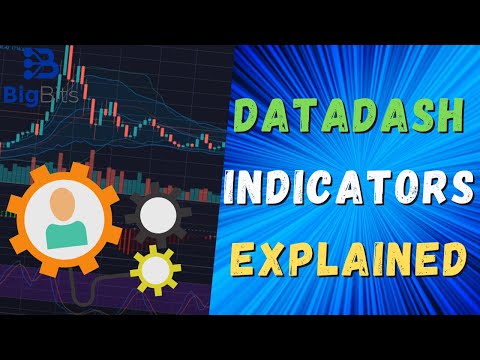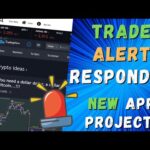YouTube Video
YouTube Video Transcript
[Music] hey this is David for big bits and in this video we’re gonna take a look at the three big indicators that Nicolas Merton uses on his YouTube channel data – and you can see I have a screenshot pulled up from one of those videos he uses the squeeze momentum indicator by lazy bear the MACD indicator and the stochastic RSI now these are all really good indicators to use they really are it’s not necessarily financial advice don’t get me wrong but when you look at the indicators a lot of people just learn how to read the indicators and not really understand why they work the way they do so for example let’s look at the squeeze momentum indicator on the chart here you can see as price goes up you know it turns green and continues to go up and this price goes down it trends downward but why does it do that and what are these gray and black squares or crosses here excuse me and I’m gonna go into that in this video so if you don’t know how the squeeze momentum indicator works you don’t know how that Matt do you works or the stochastic RSI works you’re gonna learn so stick around for the rest of the video I’m gonna close this out now or minimize it and get that out of our way and let’s take a loop of charts I’ve pulled up the weekly chart kind of similar to what we had shown earlier in the image so the first one we’re gonna take a look at is the MACD now I have all of the indicators pulled up but let’s maximize this and we actually want to take a look at the source code for it so that I can tell you what it is now just by looking at this before we actually get into source code I can kind of tell you some of the things that are going on here the blue line is your actual MACD line which is your calculated line that we’re really using the orange line here is what’s referred to as a signal line sometimes and that is an average of the actual MACD line we’re gonna do that and the green and the red bars are referred to as the histogram which is the difference between these two lines so we’ll talk a bit about that as we look at the actual code for it now I’m pulling this up here the text might be kind of small if you’re watching on a phone but if you listen along you’ll get the key idea of what the indicator is actually doing here now when you look at the indicator you’ll notice it actually has several parameters and on data – on the channel he uses the defaults on all the indicators and that’s what we’re gonna do here the 1226 closed and nine the 12 and 26 these are two different moving averages that we have to calculate based on those periods there is a fast which is the 12 and there is a slow moving average which is this with 26 now by default these use the exponential moving average function so we’re getting the exponential moving average of a 12 period and 26 period moving average both of them exponential and then what we do to calculate the MACD which is the blue line is we just subtract the fast-moving exponent oh excuse me we subtract the slow moving average from the fast moving average and that gives us this line so when you’re looking at the price and you notice that things are going up you have an idea of where your moving averages might be on the chart so you would expect that your fast moving average moves up quickly and your slower moving average moves up somewhat slower now since you’re subtracting these you’re getting a difference that can go up and down below zero okay so keep that in mind when you’re looking at this that’s why the numbers go up and down below zeros because when you subtract if the slower moving average was greater than the fast moving average the MACD would be negative that’s why it goes below zero now the signal line is essentially just the same thing as calculating the s the exponential moving average for the actual price of Bitcoin or whatever chart you’re looking at and that line it’s just the average of this blue line that’s really all it is and it’s an exponential moving average if you don’t know what an exponential moving average is it basically weights the price of the most recent candles more heavy more heavily than those before it so that’s kind of how that works and I’ve already explained somewhat how these bars work and these are the histogram you can tell just by looking at there is a large difference between the MACD line and the signal line here so it produces a very large bar equal to that value that difference between those ok and you can see it’s kind of styled up nicely so that if it’s greater than it was before it’s this darker green color and if it’s reducing in size if that divergence between those two lines is decreasing getting smaller it’s a lighter green and the same thing goes once it’s below zero if it’s increasing while it’s below zero or decreasing depending on how you look at it it’s gonna get darker red and if it’s coming back up it’s gonna be this lighter red so that’s all the MACD is it’s really quite simple but it’s a very commonly used indicator it’s a good idea to get and get a perspective on what the momentum is for the chart and honestly it’s very good if you look at it here you can see it followed very well with the price action and then back down here as well it’s a very common indicator like I said now let’s move on the to the other indicator that is fairly common is the stochastic RSI it has several different default values I’m gonna get the source code out of the way in just a moment let’s take a look at this one you can tell it goes up and down and the maximum value of it here is 100 you can see it flatlines up here that’s because it does have a half of 100 it has a minimum value of zero and it touches that sometimes here on this chart and then there’s also some key levels that are highlighted on the chart for this particular indicator now I’m not going to be able to open up the source code for that one here but we’re going to actually take a look at the calculation that tradingview provides in their wiki now if you don’t know what the RSI is it is the relative strength index as another indicator with its own calculation and essentially what it is doing it is looking at the strength so the more green candles you have the higher it’ll be on the chart in it it to also ranges from 0 to 100 this is what they kind of call an oscillator it oscillates between 0 and 100 and we are going to use the stochastic calculation on the RSI value now there is a stochastic indicator that uses the price of the whatever you’re looking at you know whatever the candles are it uses that price so if you replace the RSI here with the clothes and your lowest low and your highest high and your lowest low appropriately with the prices on the chart that would be your stochastic now all we’re doing here is we’re replacing the siq astok with the RSI or the clothes excuse me with the RSI with that same stochastic calculation and we’re getting what’s known as the stochastic RSI and you can tell there are some pretty good notes here when it’s all the way at 100 then the RSI it’s at its highest level in 14 days now I do feel like I need to show the RSI here as well so let me pull up that indicator okay let’s compare these two together here let me move this over so you can actually see it we can see our RSI was increasing sarcastic RS I maxed out here and 100 while our RSI was still going up and it continued to go up that’s because the RSI was continually hitting higher highs and when you look at the stochastic RSI when it’s at 101 it’s at its highest level and the default values that we were working with the stochastic RSI those are just the different look-back periods that were actually using here now it can be just a moment let me pull up those settings and I should point out I can’t remember which one of these lines is K and D I believe the K is the blue and the D is the orange but we have our stochastic period in our RSI length what we’re doing with the RSI length is we’re calculating the RSI based on that many candles back and then we’re also after we do that then we are calculating the stochastic RSI based on the last 14 entries of the RSI and let me go back here so when we calculate the RSI this value here at the very end is calculated from 14 candles back all of that data from 14 candles back and on that’s what it’s calculated based off of now when we’re doing our stochastic RSI the stochastic RSI is looking at the last 14 periods of the RSI instead of the actual price so it has to know the previous values of the RSI before it can calculate the stochastic calculation for the RSI and that’s just common sense you have to actually have the values to be able to calculate the indicator but now you kind of have a pretty good idea of what’s going on what the RSI is excuse me what the stochastic RSI is then we have one indicator left and that is the squeeze momentum let’s take a look at this one as I might have discussed earlier when the price goes up it seemed it seems to show momentum going up on this and then it comes down goes below zero similar to the MACD it up above below zero and it sort of shows you the momentum of the price now it also shows you when there is a squeeze on price the black crosses show us squeeze the gray crosses show that there isn’t a squeeze on prices and I’ll show you how all that works in just a moment let’s see if there was anything else I want to show you right now not quite but I’m gonna go ahead and pull up this chart because that’s gonna be coming up next let’s take a look this is a squeeze momentum indicator that is being used is created by lazy bear and he’s done a very good job on the indicator and it’s one of the very popular indicators on here but we can see by the inputs that is using that we are using a Bollinger Band and a Keltner channel indicator in order to calculate the values here so the first thing he does is he calculates the Bollinger Band and I’m actually not sure if this is a bug or not but he uses the multiplier for the Keltner channels here which defaults to one point five but the Bollinger Band multi is 2.0 so if you’re using this and you’re using the input for the Bollinger Band mult then it might not be doing anything so keep that in mind for now I’ve already sent him a message or she whoever that account is ran by I’ve already sent them a message to ask them about that because that doesn’t seem right to me but going forward anyway that’s how you calculate the Bollinger Bands this is a range essentially if prices you get a moving average as your basis and then you calculate a standard deviation and you look to see what prices are within that standard deviation based on the moving average and I can actually show you that I’ve already got it pulled up these are the Bollinger Bands and I’ve already changed it to 1.5 to match what I believe is the bug in that script and you can see there is a moving average it’s a simple moving average of 20 and then there’s a standard deviation which essentially means the more volatile the price is upwards or downwards in a given time the larger the deviation is away from the center so you can see the bands get really wide when there’s a lot of price up and down on the charts within that 20 periods back on the chart we got very wide and you can see as the price narrowed and there wasn’t nearly as much volatility the bands got much tighter and that’s kind of what they referred to as the bands being squeezed when you’re talking about Bollinger Bands now that is not the only pair of bands we are looking at before I get on to the other bands that we’re looking at I want you to note that the middle band can be referred to as the middle band or the basis and this band is the upper band and the lower band and that should make sense it’s pretty straightforward the other bands we’re looking at are actually Keltner channels and these are calculated similarly to the Bollinger Bands and let’s go back to the squeeze momentum indicator and show you that we also start with a basis using a simple moving average but then we calculate a range and this is known as the true range and it’s based on the actual range of the candles instead of just using the standard deviation it’s using the range of price on the candles you can easily use true range or it will default to that calculation now once we have that it does some more math and then it comes up with the bands based on the Keltner channels this isn’t a Keltner channel indicator specifically so I’m not gonna get too much into the details on that but you can see this calculates the Keltner channels which are similar to the Bollinger Bands and they have their own bands on here now what’s being done with the squeeze momentum indicator is there’s a little bit more work done to create the actual value that you see on the bars which let’s go back to the squeeze momentum in decay so to calculate these values that are in the bars the green or the red values this calculation is created we’re getting the average of the highest high in the Keltner channel length backwards and the lowest low of the Keltner channel period going backwards once we have that then we average that in with a simple moving average the current value for the simple moving average of the Keltner channel length and that’s actually just the middle band of the Keltner channel since they’re both using the clothes then we do a linear regression using the source which is just the clothes you can see he defined that here the clothes price and the candle subtract that from that and the linear regression using the length of the Keltner channels and 0 now that’s how we come up with the bars pretty simple math huh I don’t fully understand it but we are taking some average here we take our highest high and our lowest low okay we average that in with a simple moving average so these the highest high and the low slow could either be well above or well below the Keltner channels or the Bollinger Bands but we’re averaging those together so that should be fairly close to the middle bands on either to the Bollinger Band or the Keltner channel then we average that in with the actual middle band of the Keltner channel so now they’re even closer to it and then we get a linear regression using that information taking the current price minus that and it creates that value and it is some distance off of wherever that calculated value is from the current price which creates this this bar down here but you’re probably also wondering how the squeeze actually works now to calculate whether something is a squeeze excuse me there are a few things we have to look at first we have to see if the value is above zero if it is above zero then oh this is actually doing the colors on the chart excuse me but this essentially tells it whether it’s the bright green or the regular green but for us to be able to tell whether something is being squeeze it or not we actually to come up here my apologies about that the squeeze is on which essentially means we have a black cross on that indicator if the lower Bollinger Band is above the lower Keltner channel and the upper Bollinger Band is below the upper Kellner channel what that means is both of the Bollinger Bands are within the Keltner channel which means they are smaller than it let’s see if we can actually get that to show up on the chart here so for example let’s zoom in on the chart here let’s go ahead and remove the MACD and the stochastic RSI because we’re done with those bring that over here you can see the Bollinger Bands which are this color narrow and they go well within the Keltner channels which are this brighter blue and you can see the black crosses here indicate that it is being squeezed and then once they burst out you can see that they are no longer being squeezed indicated by the gray crosses here so if you’re wondering how that indicator works that’s how it works it calculates its value based on the math that it uses we went over that and then it also looks at these bands to tell whether or not the price is currently being squeezed and you might be able to anticipate a large move so there you go we’ve went over all of the indicators used in the data – YouTube channel and I thank you for watching if you liked the video please like definitely subscribe if you want to see videos like this I have a tutorial series on how to develop indicators in Pine on trading views so if you want to learn how to make your own indicators check that video series out and excuse me I have something got in my throat I’m really sorry about that just a moment almost made it through the whole video without coughing I apologize but if you’ve learned something from this video please check out that series because you can learn a lot especially if you’re interested in development and you’re interested in trading and charts you can learn a lot from that one on how to create your own indicators like this or be something incredibly different all on your own for example I created several of my own indicators let’s go to my scripts here let’s look the smooth RSI as this is loading in this is something I created from scratch just based off of the plain RSI calculation you can see there’s a lot going on here so you can get really in-depth and you can even create your own strategies that show when you should get in and out of the chart so definitely check out that series if you can let’s subscribe to the Channel please thank you and you know have a great day hey I almost forgot to mention please also check out my profile on trading view where you can actually see all these scripts I’m talking about in that tutorial series and the ideas that I’ve posted on training view as well you can check out starting to get a lot of followers and likes on the things that we’ve done here so check that out too if you’re interested and have a great day again [Music]
YouTube Video Description
< br/> ???? IMPORTANT LINKS BELOW ????
DataDash Indicators Explained: In this video we discuss the main indicators that are used in the DataDash YouTube channel. We take a quick look at all of the indicators and attempt to explain them in simple terms.
??♂️??♂️??♂️??♂️??♂️??♂️??♂️??♂️??♂️??♂️
Social and other public profiles
??♂️??♂️??♂️??♂️??♂️??♂️??♂️??♂️??♂️??♂️
? Website: https://bigbits.io
? Discord: https://discord.gg/rapMn4z
? Twitter: https://twitter.com/BigBitsIO
? Facebook: https://www.facebook.com/BigBitsIO/
??GitHub: https://github.com/BigBitsIO
?TradingView: https://www.tradingview.com/u/BigBitsIO
???????????
Referral links
???????????
? Buy, Sell and Trade Crypto on Binance.US with LOW fees: https://www.binance.us/?ref=35105151
?♂️ Want to buy crypto? Get $10 of bitcoin w/ your first purchase over $100: https://www.coinbase.com/join/johnso_dxz
? Sign up for a paid plan at TradingView and receive a $30 credit: https://www.tradingview.com/gopro/?share_your_love=BigBitsIO
? Browse privately and get rewarded with Brave Browser: https://brave.com/big406
? Receive bonus perks when purchasing Lightnite Game: https://lightnite.io/ref=BigBits
VIEW ALL HERE: https://bigbits.io/bigbits-referrals/
❗️❗️❗️❗️❗️❗️❗️❗️❗️❗️❗️❗️❗️❗️❗️❗️❗️❗️❗️❗️❗️❗️❗️❗️❗️❗️❗️❗️❗️❗️❗️❗️❗️
DISCLAIMER: All my videos are for educational and entertainment purposes only. Nothing in this or any of my videos should be interpreted as financial advice or a recommendation to buy or sell any sort of security or investment including all types of crypto coins and tokens. Consult with a professional financial advisor before making any financial decisions. Investing in general and particularly with crypto trading especially is risky and has the potential for one to lose most or all of the initial investment. In simple terms, you are responsible for your actions when trading.
❗️❗️❗️❗️❗️❗️❗️❗️❗️❗️❗️❗️❗️❗️❗️❗️❗️❗️❗️❗️❗️❗️❗️❗️❗️❗️❗️❗️❗️❗️❗️❗️❗️
#bitcoin #crypto #cryptocurrencies #tradingview #binance #binanceUS #coinbase
This channel focuses on Bitcoin, Ethereum, LiteCoin, Ripple, Link, Basic Attention Token and almost all cryptocurrencies that demand attention. Please like the video if you liked the video, and subscribe if you like these types of videos. David from BigBits is an experienced Software Engineer, but no one is perfect, If you find any issues with any of the open-source, free code, or code shown in videos please comment to let us know what to fix, we listen to our viewers!



